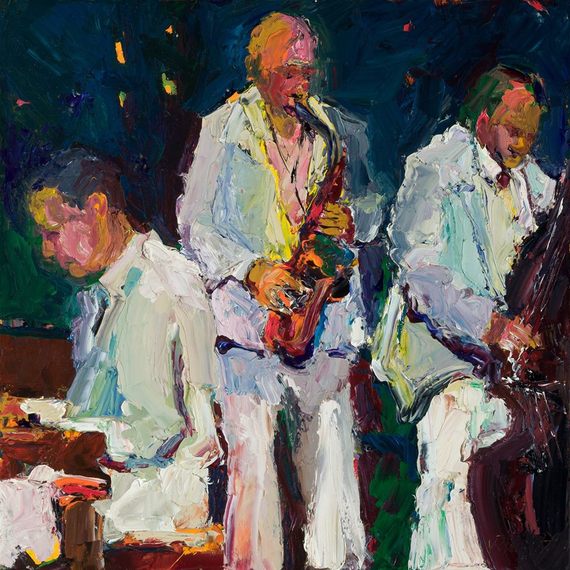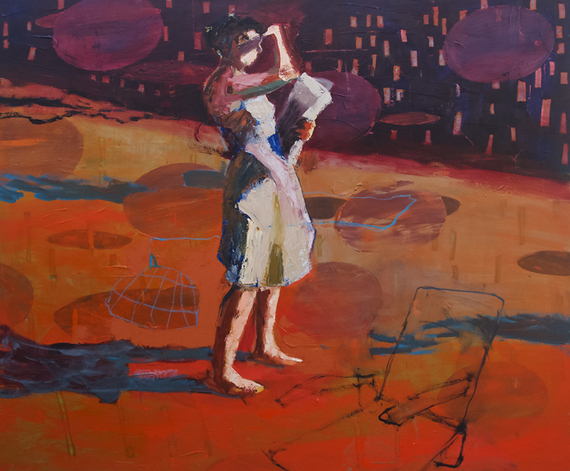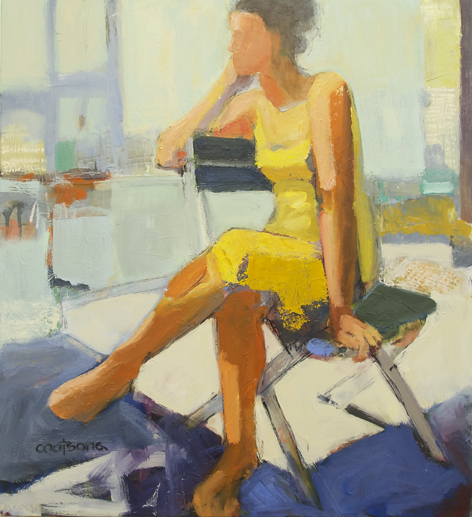Approaching the Figure: Linda Christensen, Melinda Cootsona and William Rushton at the Studio Shop in Burlingame

Rushton and his fellow-artists Linda Christensen and Melinda Cootsona are rather like the musicians in "The Jazz Trio": they are part of a community but they are also very much individuals whose works are their personal variations on a shared tradition. Each of these artists is interested in depicting the human figure from a humanistic perspective and all three artists handle paint courageously and energetically: they share a core set of values. Then again, seen as individuals there are some differences in their styles and approaches that are both subtle and striking.
Linda Christensen has recently been looking at the works of Vuillard and Matisse--as so many Bay Area artists have over time--and learning from their "Intimist" approach to the human figure. "Intimism gives a view into personal life," Christensen explains, "and in my choice of subject matter I go for the everyday." Combining loose brushwork and palette knife, Christensen tries to get her work to come alive--to "breathe"--by using long brushes and applying stencils to challenge herself as she works. Keeping in mind that painting can be like "jumping off a cliff" Christensen often stands in front of the easel and says to herself, "Here I go!"

Melinda Cootsona, who has a background in interior design and drafting, is equally interested in the human figure in relation to the spaces that surround them. She begins each composition with rough notations--she calls them "graffiti marks"--and then uses photographic references to insert and locate her figures. Cootsona has been gradually trying to take her work in a more abstract direction, partly due to Linda Christensen's influence on her work. By keeping three or four paintings going all at once she manages to keep her surfaces fresh and lively. As she explains it: "I'm very interested in layering--in pentimento--and I'm constantly putting on paint and then taking it away. "

William Rushton is very much a process-oriented painter: "I don't always know where I am going, but I know how to get there" is how he puts it. Rushton doesn't use any preliminary drawing on his canvases: he just "jumps in." Rushton's surfaces are distinctly painterly--sometimes even encrusted--but he manages to keep his colors clean and bright. Clearly at ease dealing with the creamy materiality of oil paint, Rushton likes to lose himself in the painting process, especially since he believes that "The fun part is digging myself out."
Tuned into the idea that he can put life into his figures, Rushton is interested in interaction and in depicting what he thinks of as "tipping points" which leave his viewers not sure what has just happened or what might happen next. One thing he wants to avoid--and something that he dislikes is some contemporary paintings--is the demotion of the human figure to decoration. "I don't want the figure to be wallpaper," Rushton philosophizes, "I want to create a sense of life that you can engage with and live with for awhile."
To paint like Christensen, Cootsona or Rushton, you have to be ready to improvise: as Richard Diebenkorn once wrote, you have to "tolerate chaos." Each of these three artists is very tuned into the act of painting, and each knows how to keep their paintings fresh and alive with possibilities. The Bay Area Figurative style, now more than 60 years old, has given these painters a starting point, and a sense of community. And being part of a supportive community, as William Rushton points out, is something that frees up people--and artists--to be themselves. Looking over this group show should feel rather like listening to a band of friends play a concert. Think of each canvas as a jazz solo: a riff on an existing theme that is transformed by nerve and talent into something fresh and new.
Approaching the Figure: Linda Christenson, Melinda Cootsona, William Rushton
Through October 3rd, 2015
The Studio Shop
244 Primrose Road Burlingame, CA
